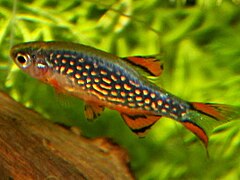Danio margaritatus
| Celestial pearl danio | |
|---|---|
 |
|
| Adult male | |
| Scientific classification | |
| Kingdom: | Animalia |
| Phylum: | Chordata |
| Superclass: | Osteichthyes |
| Class: | Actinopterygii |
| Subclass: | Neopterygii |
| Infraclass: | Teleostei |
| Superorder: | Ostariophysi |
| Order: | Cypriniformes |
| Family: | Cyprinidae |
| Subfamily: | Danioninae |
| Genus: | Danio |
| Species: | D. margaritatus |
| Binomial name | |
|
Danio margaritatus (Roberts, 2007) |
|
| Synonyms | |
|
Celestichthys margaritatus Roberts, 2007 |
|
Celestichthys margaritatus Roberts, 2007
Danio margaritatus, the celestial pearl danio, often referred to in the aquarium trade as galaxy rasbora or Microrasbora sp. 'Galaxy', is a small cyprinid from Myanmar. It has so far been found only in a very small area near Hopong east of Inle Lake, at an altitude of over 1,000 m (3,400 ft). Its habitat is part of the Salween basin, namely the Nam Lang and Nam Pawn Rivers. Discovered in 2006, the species quickly appeared in the aquarium trade, where its small size and bright colours made it an instant hit.
This is a small, plump danionin with a markedly blunt snout, measuring just 2–2.5 cm standard length. The body is about three times as long as it is high. In general shape, it resembles Danio erythromicron more than any other known species.
This species shows some sexual dimorphism: males have a bright-blue background color (dull blue-green in females), and their fins are more brightly colored. The tail end of their bodies (the caudal peduncle) is also higher than in females. The body is sprinkled with small, pearly dots. The back is bronzy green, and the belly in females is yellowish-white. The gill covers are transparent, letting the blood-red gills shine through.
The males will prominently display their unpaired fins to conspecifics. All fins, save the pectoral fins, show two parallel black lines with a bright red area in between; on the tail fin, this pattern is present twice (once on each lobe) and the outer black band is vestigial. Females have a weaker version of the pattern in the tail and dorsal fins only, sometimes in the anal fin, too.
A courting male develops a red belly and the flanks brighten and darken, making the pearly spots stand out even more, with the back appearing paler than the flanks and also standing out. A female in reproductive age can be recognized by a black anal spot which separates the belly color from the uniformly reddish base of the anal fin. The male has a small black pad at the edges of the lower jaw, which is absent or reduced in females. Immature fish show some indication of a striped pattern, which eventually decomposes into the pearly dots.
...
Wikipedia

